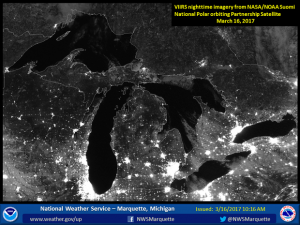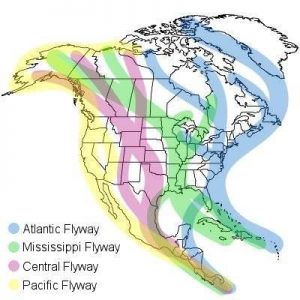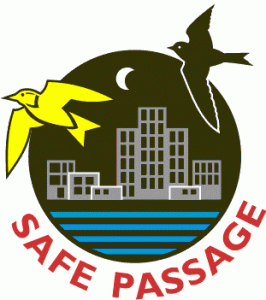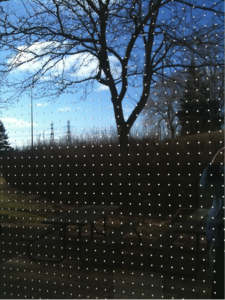How can turning off lights help birds?

NASA/NOAA polar orbiting satellite shows lights of the cities in the Great Lakes region on March 16, 2017. (NOAA/NASA)
Each spring, neotropical migratory birds leave their winter feeding grounds and fly north to summer breeding sites. Each fall, when the young outgrow their nest and insect populations dwindle, the birds return to warmer climates where food is more abundant. Many of these species migrate at night. And tragically, many of these birds do not complete their journey due to a simple man-made issue: we left the lights on.
Birds migrating at night are attracted to artificial sources of light, particularly during periods of inclement weather. As birds approach the lights of tall buildings, communications towers, lighthouses, floodlit obstacles, and other lit structures, they become vulnerable to collisions with the structures themselves. Even if collisions with these structures are avoided, birds are still vulnerable. “Once inside a beam of light, birds are reluctant to fly out of the lighted area into the dark, and often continue to flap around in the beam of light until they drop to the ground with exhaustion. A secondary threat resulting from their aggregation at lighted structures is their increased vulnerability to predation. The difficulty of finding food once trapped in an urban environment may present an additional threat.” [www.flap.org]
Safe Passage Great Lakes
 Millions of birds migrate through the Great Lakes every year, using wetlands, forests, shoreline and more than 32,000 islands as stopover sites. Reducing building lighting during migration seasons can drastically reduce the hazard of building collisions. In 2006, the Detroit Audubon Society initiated Safe Passage Great Lakes. In partnership with Michigan Audubon, this program encourages building owners and occupants to turn off lights above the fifth floor, and take other simple steps during the peak migration seasons of mid-March through May and mid-August through October to reduce the danger as migrants pass through. Major cities in our region including Chicago and Toronto, as well as New York City, Washington D.C., Portland, Oregon, and many others, have started similar programs with demonstrated records of success.
Millions of birds migrate through the Great Lakes every year, using wetlands, forests, shoreline and more than 32,000 islands as stopover sites. Reducing building lighting during migration seasons can drastically reduce the hazard of building collisions. In 2006, the Detroit Audubon Society initiated Safe Passage Great Lakes. In partnership with Michigan Audubon, this program encourages building owners and occupants to turn off lights above the fifth floor, and take other simple steps during the peak migration seasons of mid-March through May and mid-August through October to reduce the danger as migrants pass through. Major cities in our region including Chicago and Toronto, as well as New York City, Washington D.C., Portland, Oregon, and many others, have started similar programs with demonstrated records of success.
Get Involved
There are many ways you can help provide safe passage for migratory birds. Whether you are a building owner, a building tenant, or a homeowner, reducing light pollution especially during spring (March 15-May 31) and fall migration (August 15-October 31) will help our migratory birds.
 Here are a few simple steps you can take or encourage other to take:
Here are a few simple steps you can take or encourage other to take:
- Turn off unnecessary exterior lights or pull shades at night.
- Turn off unnecessary lighting in lobbies or atriums.
- Turn off decorative landscaping lighting.
- In office buildings, turn off lighting on the outside perimeter offices and use only interior office lights if needed. If lighting must be left on, use curtains to block light from escaping.
- For late-night workers, use task lighting where possible.
- Ask cleaning staff to turn lights on as needed, and turn lights off after they complete their work.
- Add proper decals and window treatments that deter daytime bird strikes.
Make a Safe Passage Pledge
 By pledging to participate in Safe Passage Great Lakes, you are contributing to state-wide bird conservation. Your actions may inspire your neighbors, friends, and colleagues to help as well. As a community, we can make a make a significant difference for the millions of migratory birds that pass through the Great Lakes each year. Thank you for helping the birds!
By pledging to participate in Safe Passage Great Lakes, you are contributing to state-wide bird conservation. Your actions may inspire your neighbors, friends, and colleagues to help as well. As a community, we can make a make a significant difference for the millions of migratory birds that pass through the Great Lakes each year. Thank you for helping the birds!
We consider your pledge to be on-going. Michigan Audubon will send a reminder before spring and fall migration begins. If you represent a business or organization, we will add you to our list of migratory bird supporters.
From the entire Michigan Audubon team, thank you!
Resources
Visit the links below to learn more about making your city, town, community, neighborhood, or home safer for our feathered friends.
- Fatal Light Awareness Program (FLAP) Canada
- Effective Window Solutions from the American Bird Conservancy
- Outdoor Lighting Basics
- Bird-friendly Building Guidelines from the American Bird Conservancy
- Bird-friendly Building Guidelines from the Audubon Society of Portland
- How to help a bird injured from a window strike
Have Questions?
If you would like to learn more about making your community more bird-friendly, please email birds@michiganaudubon.org.

